Other Oriental Plants, Flowers and Trees
Japanese Garden Design
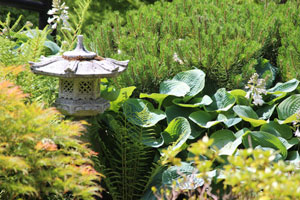
Although your first choice for any Japanese garden plants will likely be an acer (maple) or two, a pot of tall bamboo or perhaps an azalea, there are many, many other possibilities that can add instant 'age' to your garden, particularly when large specimens are chosen.
Always do some prior research before your purchase, making sure that you have the correct growing conditions required and the necessary space for your plant to grow happily.
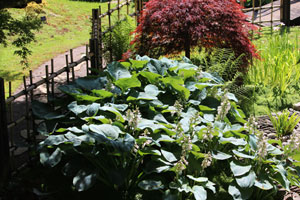
Pine Trees
In any 'normal' garden, the fact that a white or black pine tree may get too tall for its position would make it an impractical choice.
However, in a Japanese garden, it is quite common for pine trees and other species to be pruned into attractive shapes, with cloud-like branches and foliage pads, thereby keeping them artificially dwarfed and stopping them from outgrowing their allocated space.
Cherry Trees
Japanese cherry blossom trees are a real must if you have the space, with festivals being dedicated to these beautiful springtime flowers all over the world.
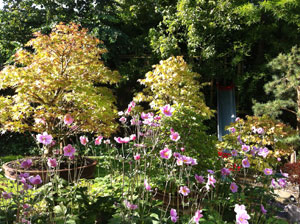
The choice of cherry (prunus) tree cultivars is extensive and if you are looking for a really authentic variety for a relatively small garden, then prunus serrulata 'Kanzan' is a reliable cultivar, with its double pink flowers being a real spectacle and transforming the tree into a giant mass of candyfloss for a few weeks each year.
Magnolias
A magnolia is another popular flowering tree that brings an endless amount of seasonality to a Japanese garden, with large tulip-like flowers adorning the branches of this tree as soon as it starts to awaken after a cold winter.
Ginkgo Bilobas
For a vibrant butter-yellow autumnal display, a ginkgo biloba (maidenhair tree) is a real must, with this typically oriental tree being planted in countless Japanese gardens throughout the world. Known for its heart-shaped leaves and medicinal uses, ginkgo trees have a very upright growth habit and although deciduous, this species does belong to the coniferous family.
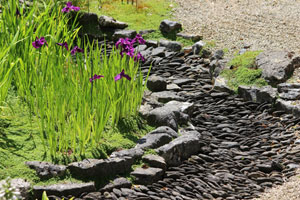
Wisterias
Suitable to grow in a pot or in the ground, climbing Chinese (sinensis) and Japanese (floribunda) wisterias can be trained over a pergola or even grown as spreading standard trees, where a single stem is trained up a strong post.
By trimming the shoots towards the end of the summer, the wisteria can be shaped as a giant umbrella, with the spring bringing a spectacular display of cascading purple flower racemes.

Sacred Bamboo, Ferns and Flowers
Other plants that don't look out of place in a Japanese garden are hostas and ferns, both of which favour a slightly shady and damp position. Nandina domestica (domestic heavenly / sacred bamboo) is a reliable plant, with its white flowers appearing in the early part of summer, followed by delicate bronze-coloured leaves that soon turn green.
Iris plants also provide the garden with a mass of seasonal blooms, flowering in the early summer with showy white, yellow and purple blossoms. Also providing a splash of colour, montbretia (crocosmia) comes with grass like foliage, being perfect for a shady corner and boasting delicate orange flowers towards the end of the summer.
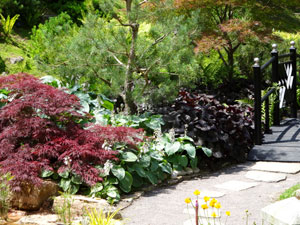
Camelias and Herbaceous Plants
A camelia or two may well appeal, provided that you have an ericaceous soil. For showy pastel pink flowers from summer into autumn, herbaceous Japanese anemones are highly recommended, although they should be given plenty of room, since they have a tendency of spreading and quickly filling large spaces with their potentially invasive growth habit.
Maple Alternatives
Quicker growing than a Japanese maple (acer palmatum), but boasting similar leaves and a spectacular autumn colour, is the liquidambar tree (sweetgum), while for dissected foliage, a cut-leaf elder may be worth planting. Suitable elder varieties include Sambucus racemosa 'Sutherland Gold' (green) and Sambucus nigra laciniata (purple).
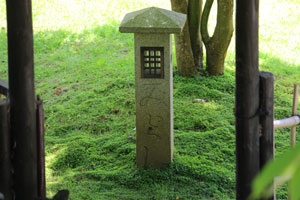
Moss and Groundcover Plants
Moss is always an important part of any Japanese garden, although it requires damp and shady conditions to grow well, and blackbirds can often pull a moss lawn to pieces looking for grubs. Therefore, many Western gardeners prefer to use substitute groundcover plants, which have the appearance of moss but are easier to grow.
Suitable moss replacements include 'mind your own business' or 'baby's tears' (soleirolia soleirolii), Corsican mint (mentha requienii), non-flowering lawn camomile (chamaemelum nobile Treneague) and leptinella (cotula minima), all of which come with delicate green leaves, although these plants can be invasive unless kept under control. Some varieties of thyme, sedum and other Alpine plants may also be suitable, having the advantage that they flower as well as providing a dense carpet of green foliage.
 Although your first choice for any Japanese garden plants will likely be an acer (maple) or two, a pot of tall bamboo or perhaps an azalea, there are many, many other possibilities that can add instant 'age' to your garden, particularly when large specimens are chosen.
Although your first choice for any Japanese garden plants will likely be an acer (maple) or two, a pot of tall bamboo or perhaps an azalea, there are many, many other possibilities that can add instant 'age' to your garden, particularly when large specimens are chosen.
 The choice of cherry (prunus) tree cultivars is extensive and if you are looking for a really authentic variety for a relatively small garden, then prunus serrulata 'Kanzan' is a reliable cultivar, with its double pink flowers being a real spectacle and transforming the tree into a giant mass of candyfloss for a few weeks each year.
The choice of cherry (prunus) tree cultivars is extensive and if you are looking for a really authentic variety for a relatively small garden, then prunus serrulata 'Kanzan' is a reliable cultivar, with its double pink flowers being a real spectacle and transforming the tree into a giant mass of candyfloss for a few weeks each year.


